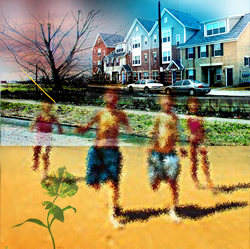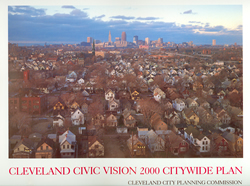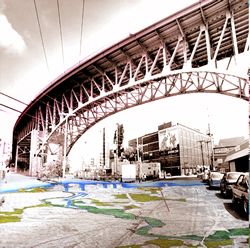 |
 |
What is the measure of a great city? The height of its skyscrapers? The size of its convention center? The number of Fortune 500 companies within its borders? The records of its sports teams? Although each of these can contribute to greatness, the ultimate measure of a city’s greatness is the quality of life it offers to its citizens.
A great city connects its citizens to great choices in housing, education, employment, services, shopping, entertainment and culture as well as to opportunities to live in neighborhoods that are safe, secure and vibrant. A great city truly can be a place that nurtures the body, the mind and the spirit of those who choose to make the city home.
Just as importantly, a great city is a “city of choice and of choices” not just for its most privileged but also for those who have been denied access to many of the pathways that can lead to success and fulfillment in life.
The Connecting Cleveland 2020 Citywide Plan is the new comprehensive plan for the future of Cleveland and its neighborhoods. This Summary presents a preface to the plan and highlights the plan’s citywide recommendations. The full plan treats these citywide issues in greater detail, presents a block-by-block “future land use map,” and focuses attention on each of 36 City neighborhoods.
THE COMPREHENSIVE PLAN
Cleveland’s City Charter (in Section 76-2) directs the City Planning Commission to “make and adopt a general plan for the development and improvement of the city.” This “general plan,” more commonly known as a “comprehensive plan,” serves as a blueprint or a roadmap for development and revitalization activities in the City.
The comprehensive plan establishes an overarching vision of the City’s future, typically looking out at least ten years, and provides guidance on development-related decisions that must be made on a day-to-day basis. Although some of a plan’s recommendations will occur quickly, it is important to understand that other recommendations will occur only when market conditions are right or when necessary funding becomes available. Given this limited availability of public funds and the limited availability of land, the comprehensive plan is an essential tool in ensuring that the City makes the best use of these scarce resources and in preventing the City from pursuing policies or supporting projects that work at cross-purposes.
The current plan presents its vision in the form of a “future land use map” and a wide-ranging set of goals, policies and implementation strategies.
|
 |
Evolution OF A Civic Vision
Between 1950 and 1990, Cleveland lost nearly half of its population and more than half of its jobs in manufacturing, historically the city’s top job-producing sector. The concurrent increase in urban sprawl left behind a host of problems including vacant property, unemployment and contaminated land. As these challenges became increasingly evident, so too did the lack of a comprehensive strategy to address them and to take advantage of the emerging market for redevelopment.
Cleveland ’s Civic Vision 2000 Plan, completed in 1990, confronted these challenges by presenting a vision to re-structure Cleveland as a smaller but more viable city. The plan fostered the concentration of retail businesses in strategically located “neighborhood town centers.” The plan also facilitated creative re-use of excess industrial and commercial land, a resurgence in residential development, new industrial parks near freeway interchanges, and increased attention to urban design issues.
Although Civic Vision, in many respects, put Cleveland back on track, it has been aptly observed, “even if you are on the right track, you will get run over if you just sit there.”* The 21 st century presents Cleveland with challenges and opportunities that were not fully anticipated in 1990. Among the most pressing is the accelerating shift toward a knowledge-based economy – both a challenge and an opportunity for a city struggling to educate its children, yet rich in institutions of higher education and medical innovation. Just as significant are new opportunities to create competitive, mixed-use urban communities, fueled by changing demographics and changing lifestyles.
The redevelopment successes of the 90’s made it increasingly evident to Clevelanders that physical development is not enough, as debilitating poverty persisted in the shadows of new buildings rising across the urban landscape. Unaddressed social needs have a way of undoing the best-laid plans of architects and planners. It is clear that “place-based” strategies addressing land use and physical development must be coupled with “people-based” strategies that address people’s needs for connections to education, jobs, services, recreation and the arts, as well as the need for “connectedness” to neighbors and to a supportive community.
Cleveland , however, is a resilient city that has the ability to use the assets it built during its peak years to re-invent itself as a competitive place to live and do business for generations to come.
*Will Rogers, early 20 th century American humorist
|
 |
CONNECTING CLEVELAND
The theme of the new Citywide Plan is “connections.” The plan is premised on the understanding that a great city is not merely a collection of buildings, but it is a place of connections – connections between people and places and opportunities. At its simplest, a connection can be a bike path that connects a neighborhood to the waterfront or a bus line that connects people to jobs. At its most fundamental, a connection can be a shared space – an urban plaza, a neighborhood park, a community institution or even a coffee shop – that connects people to one another in a way that creates a sense of “place” and a sense of belonging – that elusive but enduring thing that we call “community.”
Other essential connections link people to the diverse opportunities available in a city – opportunities that for some city residents are so close but yet have remained just out of reach. These are connections to education, social services, jobs, health care, shopping, entertainment, the arts and culture – the full array of opportunities and resources that only a large metropolitan area can provide. In this sense, the Connecting Cleveland 2020 Citywide Plan is a plan that connects the “physical” and the “social” to create communities that are truly viable and sustainable |
Continue to the Next Section: Cleveland in Perspective |
 |





